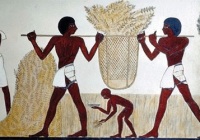Topic Wine in Mesopotamia
It has usually been argued that barley beer was the alcoholic beverage of choice in ancient Sumer, since the hot, dry climate of southern Iraq makes it difficult to grow grapevines, and the textual evidence for viniculture and winemaking in Mesopotamia is minimal before the 2nd millennium B.C. But based on chemical evidence for wine inside jars that could’ve been used to transport and serve it, wine was probably already being enjoyed by at least the upper classes in Late Uruk times (ca. 3500-3100 B.C.). Early Dynastic cylinder seals depict the royalty and their entourages drinking beer with tubes/straws from large jars and a second beverage—presumably wine—from hand-held cups.
The wine imported into lowland Greater Mesopotamia could have been brought from the northern Zagros Mountains of Iran or other parts of the Near East, at least 600 kilometers away. The 5th century B.C. Greek historian Herodotus describes shipping wine down the Euphrates or Tigris from Armenia at a much later period: round skin boats were loaded with date-palm casks of wine and delivered to Babylon. River transport was also an option in the Late Uruk Period. But if the demand for the beverage were great enough, transplantation of grapevines to closer locales in the central Zagros and possibly as far south as Susa would be anticipated. When the Late Uruk trade routes were suddenly cut off at the end of the period, the pressure to establish productive vineyards closer to the major urban centers would have intensified.
Future excavation will be decisive in tracing the prehistory of viniculture and winemaking in this region of the ancient Near East; already there is a strong indication that the domesticated grape plant had already been transplanted there as early as the mid-3rd millennium B.C. Elamite cylinder seals, foreshadowing similiar scenes on Assyrian reliefs some two millennia later, depict males and females seated under grape arbors, drinking what is most likely wine.
Original article:
Did you know…?
Museum scientists have analyzed what participants ate and drank at the final funerary feast of King Midas at Gordion (ca. 700 B.C.) and discovered that it was lamb stew and a mixed fermented beverage of wine, barley beer, and honey mead!





I like this blog.I love everything that fits ancient period.
LikeLike
[…] First posted July 28, 2010 via Mesopotamia […]
LikeLiked by 1 person